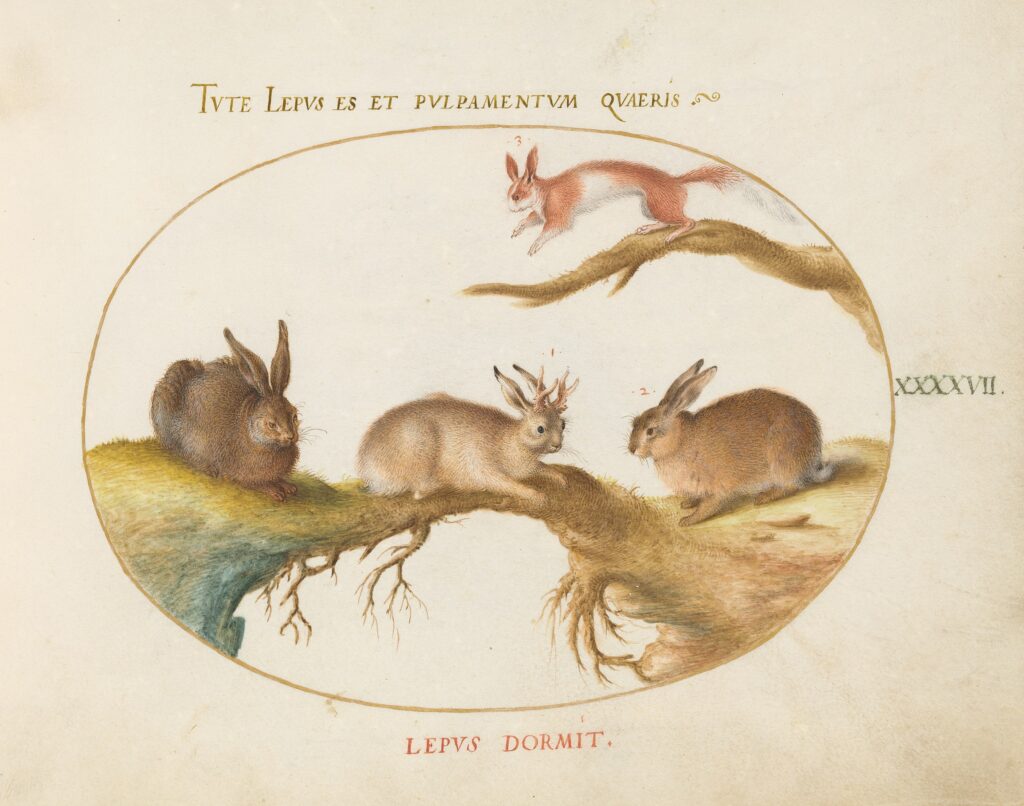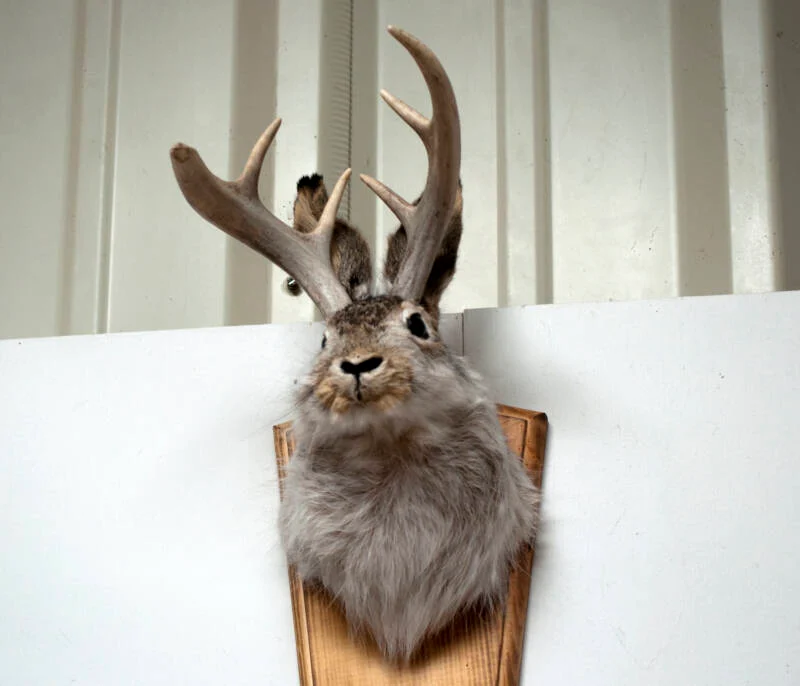For generations, the American West has been a realm of mythical stories and legends that have stirred the popular imagination, with accounts of cowboys, outlaws, and legendary creatures. But perhaps no cryptid is as beloved or enduring as the jackalope, a strange and wondrous beast that is rumored to roam the wilds of the Western United States.
Often described as part rabbit, part antelope, and with small horns sticking from its head, the jackalope is a creature that has come to symbolize the untamed spirit of the American West. From its murky origins to its current place in popular culture, this curious creature has become an icon of the Western frontier.
What is the legendary jackalope, and where did it come from? And what exactly is it about the jackalope that so deeply captures the imaginations of so many?

A Legendary Animal Hybrid
The physical specimen of the jackalope is a fascinating mix of two distinct, real animals: the jackrabbit and the antelope. Its name also is a clear ‘portmanteau’ – or a blend of words – of the two animals. The resulting creature has the body of a jackrabbit, a type of hare distinct from rabbits, but with antlers that resemble those of an antelope or deer.
Wyoming, where the legend of the jackalope originated, is commonly home to three species of hares – the black-tailed and white-tailed jackrabbits, as well as the elusive snowshoe hare.
Meanwhile, the antelope portion of the jackalope’s appearance is a pronghorn, a mammal that is more closely related to giraffes than to true antelopes. They are also native to Wyoming and some of the largest herds of their species are found roaming throughout the state.
Altogether, the jackalope is through-and-through a product of the state of Wyoming – and in more ways than one.
Douglas, Wyoming & the Origins of the Jackalope
According to the New York Times, the myth of the American jackalope can be traced back to a 1932 hunting trip in Douglas, Wyoming, involving two teenage brothers who had studied taxidermy.
Upon returning home from a jackrabbit hunting trip, Douglas Herrick and his brother unintentionally started one of the most lasting legends of the American West. As one of the brothers tossed a dead rabbit carcass next to a pair of deer antlers in their taxidermy shop, the accidental combination of animal forms on the floor sparked an idea.
Using their taxidermy skills, the first ‘jackalope’ was created. Not long after, they sold the new creature for $10 to a man named Roy Ball. Ball displayed the jackalope in Douglas’ La Bonte Hotel, where it quickly became a popular attraction, drawing the attention of the entire town.

The famous, original horned-hare, however, was stolen in 1977 – further adding to the intrigue and interest in the myth – and the culprit was never caught.
Today, the town of Douglas celebrates its jackalope heritage. It hosts an annual Jackalope Days Celebration in early June and issues Jackalope Hunting Licenses to tourists for the official jackalope season, which lasts for one day: June 31 (an obviously fake date – June has 30 days) from midnight to 2am.
While the popular myth of the jackalope was borne out of mischief and trickery, the lore took hold in popular culture.
Other Jackalope Hybrids in Folklore
The jackalope myth may also have origins in various cultures worldwide, where stories or descriptions of animal hybrids, such as the horned rabbit, have appeared before modern times.
In Medieval and Renaissance folklore in Bavaria, the wolpertinger, a creature similar to the jackalope, was described. Early scientific texts and illustrations from the 16th and 17th centuries also included depictions of the ‘horned hare,’ which were depicted as real creatures.
Legends about horned rabbits are not limited to Europe. These myths and representations are also seen in Asia, Africa, and Central America. Huichol legends make references to a horned rabbit creature, similar to the concept of a jackalope. The Huichol oral tradition has passed down these tales for generations, telling of a horned rabbit that then gives the deer its horns.
It’s possible that any or all of these earlier legends and myths helped plant the idea of the jackalope in the heads of Douglas Herrick and his brother. But even without their taxidermic invention, the folklore of the jackalope has always been difficult to avoid.
Where then does the myth of the horned hare come from, if they don’t supposedly exist at all?
Some Basis in Reality?
While it is more than likely that Herrick’s taxidermy and creativity account for most of the jackalope’s mythical place in our culture today, it may have some basis in science.
One possible explanation for the jackalope myth is that it was inspired by the Shope papilloma virus, which causes hard, keratinized horns to grow on rabbits infected by the virus. These horned rabbits have been observed since medieval times and, as aforementioned, appear throughout Bavarian folklore and early scientific texts.
In many of the infected rabbits, the papilloma growths manifest on the face and head, sometimes impacting their ability to eat and survive, but other times causing little disruption. If located around or behind the ears, they would certainly take on the appearance of small horns protruding from the skull.
However, not all rabbits infected with the virus grow horns, and it remains uncertain if the horned rabbit truly inspired the jackalope myth.
The Jackalope in American Popular Culture
The jackalope myth has firmly entrenched itself in American pop culture, becoming a beloved symbol of the American West.
The creature has inspired a plethora of merchandise, from t-shirts and hats to stuffed toys and bottle openers. It has even found its way into popular media, appearing in many films, TV shows, and books.
But more than just a quirky legend, the jackalope has also come to symbolize the American spirit and legacy of exploration. Its mythic status stands a reminder of American imagination and creativity.
As such, it has rightfully earned its place in the pantheon of American cryptid folklore, and will no doubt continue to capture the imaginations of generations to come.
If you enjoyed this article, read more about the mysterious Skinwalker Ranch, the bloodsucking Chupacabra of Mexican and American mythology, or Changelings who steal impersonate your children.
References
Jemison, Micaela. “The World’s Scariest Rabbit Lurks within the Smithsonian’s Collection.” Smithsonian Sparks, Smithsonian Institution, 17 June 2020, https://www.si.edu/stories/worlds-scariest-rabbit.
“The Legend of the Jackalope.” The Legend of the Jackalope, City of Douglas Wyoming, https://www.cityofdouglas.org/255/The-Legend-of-the-Jackalope.
Santora, Tyler. “Are Jackalopes Real?” LiveScience, Future US Inc, 4 Dec. 2021, https://www.livescience.com/are-jackalopes-real.
Simon, Matt. “Fantastically Wrong: The Disturbing Reality That Spawned the Mythical Jackalope.” Wired, Conde Nast, 14 May 2014, https://www.wired.com/2014/05/fantastically-wrong-jackalope/.


thank you for the article